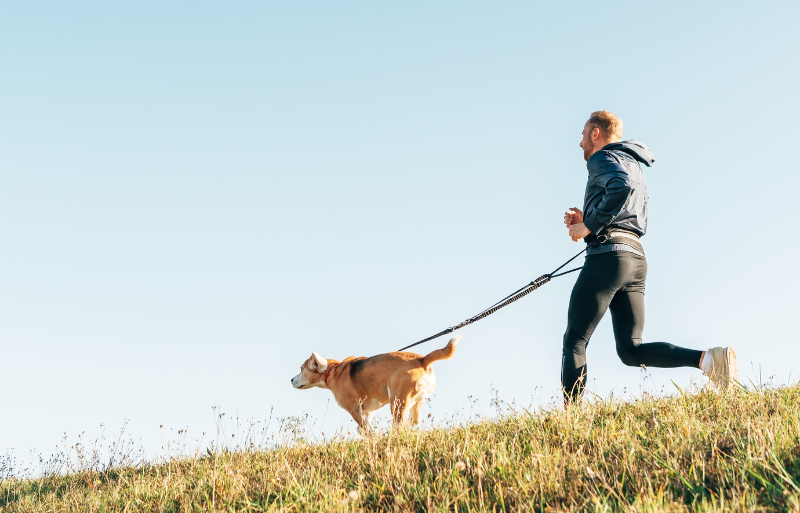Spending time with our dog(s) is one of life’s greatest joys.
They make everything more fun, and exercise is no exception.
But before we include our furry pal in our workout routine, it’s helpful to know which activities are best for them.
Today, we’ll learn about four exercises we can do with our dogs, and tips to keep them safe and comfy throughout.
1. Hiking
Hiking provides a full-body workout that can be adjusted depending on skill level. Whether we’re exploring flat maintained trails or steep backcountry hills, hiking keeps us strong.
It improves our heart and lung health, lower body strength, and bone health. Spending time outdoors can also help us get vitamin D, necessary for strong bones and immune health.
Hiking also lets us spend time in nature. This may reduce anxiety and feelings of isolation, and increase mental clarity.
It also helps dogs build strong bodies, and stimulates their minds.
How to Prepare:
- Make sure our dog is in good physical health.
- Ensure our dog’s vaccines are up to date. We should also ask our vet about preventative treatments for our region.
- Start with short, easy hikes and increase difficulty as our dog’s stamina increases.
- Get a reflective dog vest if hiking in low light.
- Try out a dog backpack, so they can carry their own gear (food, water, poop bags, etc.).
- Keep dogs leashed and on the trail. This helps protect wildlife and our dog.
- Protect paws with hiking booties.
- Leave no trace.
2. Biking
Riding a bike for one hour at a moderate pace burns approx. 600 calories. Aside from helping us maintain healthy body weight, biking helps us:
- Build strong lungs
- Strengthen our lower body
- Improve spatial awareness and navigation skills
- Improve heart health
Bringing our dogs can also benefit their heart health and help them burn energy.
How to Prepare
- Introduce our dog to bikes. Some dogs may be scared of bikes, especially if they haven’t been around them.
- Get a bike leash bar. This helps keep our dog beside the bike. It protects them from getting run over or stuck in the bike wheels. Using a normal leash attached to our handlebars is dangerous for us and them.
- Don’t take dogs biking on hot days.
- Protect dog’s feet. If the pavement is too hot, it can burn their paws. Even when the weather isn’t a concern, rough surfaces can be harmful. Dog shoes with rubber soles help protect their paws.
If our dog isn’t suited for running beside our bike, we can take them in a basket (if they fit). This is a nice way for us to bring our pals without risking their health.
3. Swimming
Swimming is a great full-body exercise for us and our dog. It’s also low impact, which protects joints from injury.
How to Prepare:
- Consider our dog’s breed and ability to swim. Some breeds, like retrievers, will naturally love water and know how to swim. Other breeds will be uncomfortable around water.
- Get a well-fitted dog life jacket, regardless of breed and swimming ability.
- Use dog water shoes to protect their paws from submerged rocks and debris.
- Check the water for hazards, specifically if not in a swimming pool.
- Make sure our dog is well trained to take commands. This will keep them safe in/around water.
- Dry dog’s ears after each swim, to avoid infection.
4. Kayaking
Kayaking (or canoeing, paddleboarding, etc.) is a fantastic upper body workout, including arms, back, and core. It also improves heart health and endurance.
The longer we paddle, the more capable at kayaking we become. Also, it’s a great way to spend time in nature.
Since our dogs can’t paddle, they don’t get these exercise benefits. But they might still enjoy the ride.
How to Prepare:
- Make sure our dog is a strong swimmer, in case the kayak tips or they jump in unexpectedly.
- Introduce our dogs to the kayak on land, until they’re comfortable with being in and around it. Using treats to encourage them may be helpful.
- Practice how our dog will get in and out of the kayak.
- Use specific kayak-related commands for getting in/out, going to their place when onboard, leaving objects/distractions alone while on the water, etc.
- Create a comfortable place for our dog to lay.
- Get a dog life jacket.
- Apply dog sunscreen for dogs at high risk for sunburn (light fur, hairless, pink ears/nose/eye area).
- Bring food, water, and toys.
Summary
For all activities listed, we should make sure our dog is healthy enough to participate. We should also bring a pet first aid kit for accidents.
In most cases, working out with our dogs provides physical and mental benefits for us and them.
With a few precautions, exercise can be a safe, healthy way to spend more time with our furry best friend.
Sources:
https://doglab.com/exercise-with-your-dog/
https://www.cyclingweekly.com/news/latest-news/benefits-of-cycling-334144
https://spca.bc.ca/news/swimming-safely-dog/
https://www.hsph.harvard.edu/nutritionsource/vitamin-d/
https://wellness.mcmaster.ca/7-benefits-of-spending-time-in-nature/

